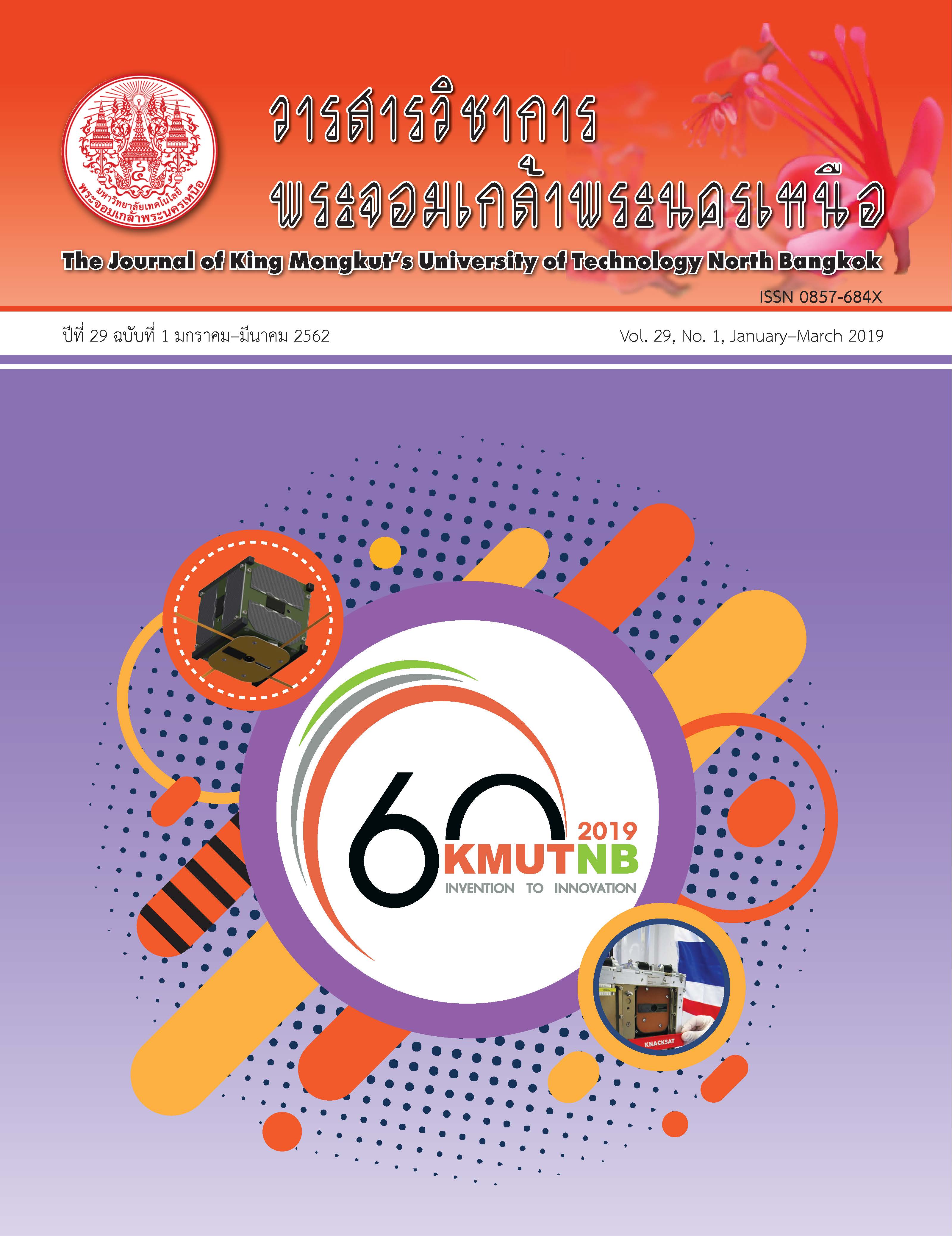ผลของสภาวะการอบต่อการคงอยู่ของกลิ่นถั่วและสมบัติทางเคมีของแป้งถั่วดาวอินคา
Main Article Content
บทคัดย่อ
กลิ่นถั่วเป็นกลิ่นเฉพาะตัวของผลิตภัณฑ์จากถั่วซึ่งไม่เป็นที่ต้องการของผู้บริโภค งานวิจัยนี้มีวัตถุประสงค์เพื่อศึกษาผลของสภาวะการอบต่อการคงอยู่ของกลิ่นถั่วและสมบัติทางเคมีของแป้งถั่วดาวอินคา จากการแปรอุณหภูมิการอบเป็น 70, 90 และ 120 องศาเซลเซียส ร่วมกับการใช้เวลาอบ 15 และ 30 นาที พบว่า สภาวะที่ใช้สามารถทำให้กลิ่นถั่วลดลงได้ โดยอุณหภูมิและเวลาการอบมีผลต่อกิจกรรมของเอนไซม์ไลพอกซีจิเนส และความเข้มกลิ่นถั่ว (p < 0.05) และอุณหภูมิการอบมีผลต่อปริมาณความชื้น (p < 0.05) โดยสภาวะการลดกลิ่นถั่วที่เหมาะสม คือ การอบที่อุณหภูมิ 120 องศาเซลเซียส เป็นเวลา 15 นาที เมื่อเปรียบเทียบคุณภาพทางเคมีของแป้งถั่วดาวอินคาที่ผ่านและไม่ผ่านการอบ พบว่า มีความแตกต่างกันอย่างมีนัยสำคัญทางสถิติ (p < 0.05) แป้งถั่วดาวอินคาที่ผ่านการลดกลิ่นถั่วด้วยการอบที่อุณหภูมิ 120 องศาเซลเซียส เป็นเวลา 15 นาทีมีความชื้น โปรตีน ไขมัน กากใย เถ้า เส้นใยอาหารทั้งหมด และสารประกอบฟีนอลิกทั้งหมดต่ำกว่าแป้งถั่วดาวอินคาที่ไม่ผ่านการอบ (p < 0.05)
Article Details
บทความที่ลงตีพิมพ์เป็นข้อคิดเห็นของผู้เขียนเท่านั้น
ผู้เขียนจะต้องเป็นผู้รับผิดชอบต่อผลทางกฎหมายใดๆ ที่อาจเกิดขึ้นจากบทความนั้น
เอกสารอ้างอิง
[2] T. G. Kudre and S. Benjakul, “Effects of binary organic solvents and heating on lipid removal and the reduction of beany odour in Bambara groundnut (Vigna subterranean) flour,” Food Chemistry, vol. 141, no. 2, pp. 1390–1397, 2013.
[3] D. J. Shin, W. Kim, and Y. Kim, “Physicochemical and sensory properties of soy bread made with germinated, steamed, and roasted soy flour,” Food Chemistry, vol. 141, no. 1, pp. 517–523, 2013.
[4] Official method of analysis, AOAC USA. Methods 925.10, 65.17, 974.24, 992.16., 2000.
[5] Y. Hu, J. Xu, and Q. Hu, “Evaluation of antioxidant potential of Aloe vera (Aloe barbadensis Miller) extracts,” Journal of Agricultural and Food Chemistry, vol. 51, no. 26, pp. 7788–7791, 2003.
[6] X. Kong, X. Li, H. Wang, Y. Hua, and Y. Huang, “Effect of lipoxygenase activity in defatted soybean flour on the gelling properties of soybean protein isolate,” Food Chemistry, vol. 106, no. 3, pp. 1093–1099, 2008.
[7] J. R. Runyon, B. A. Sunilkumar, L. Nilsson, A. Rascon, and B. Bergenståhl, “The effect of heat treatment on the soluble protein content of oats,” Journal of Cereal Science, vol. 65, pp. 119–124, September 2015.
[8] J. N. Nwosu, C. N. Ubbaonu, E. O. I. Banigo, and A. Uzomah, “The effects of processing on the amino acid profile of Oze (Bosqueia angolensis) seed flour,” Life Science Journal, vol. 5, no. 4, 2008.
[9] P. B. Ayoola and A. Adeyeye, “Effect of heating on the chemical composition and physicochemical properties of Arachis hypogea (Groundnut) seed flour and oil,” Pakistan Journal of Nutrition, vol. 9, no. 8, pp. 751–754, 2010.
[10] K. Vongsumran, W. Ratphitagsanti, P. Chompreeda, and V. Haruthaitanasan, “Effect of cooking conditions on black bean flour properties and its utilization in donut cake,” Kasetsart Journal, vol. 48, pp. 970–979, 2014.
[11] Q. Li, X. Shi, Q. Zhao, Y. Cui, J. Ouyang, and F. Xu, “Effect of cooking methods on nutritional quality and volatile compounds of Chinese chestnut (Castanea mollissima Blume),” Food Chemistry, vol. 201, pp. 80–86, 2016.
[12] M. Johansson, “Dietary fibre composition and sensory analysisof heat treated wheat and rye bran,” M.S. thesis, Department of Food Science, Faculty of Natural Resources and Agricultural Sciences, Swedish University of Agricultural Sciences, 2012.
[13] H. P. Hanssen and M. Schmitz-Hubsch, “Sacha Inchi (Plukenetia volubilis L.) Nut Oil and Its Therapeutic and Nutritional Uses,” Nuts and Seeds in Health and Disease Prevention, pp. 991–994, 2011.
[14] U. E. Inyang, E. O. Akpan, and F. A. Bello, “Effect of boiling and roasting on the nutrient and anti-nutrient contents in conophor nuts flour,” International Journal of Information Research and Review, vol. 2, no. 6, pp. 769–772, 2015.
[15] I. A. Blessing and I. O. Gregory, “Effect of processing on the proximate composition of the dehulled and undehulled mungbean [Vigna radiata (L.) Wilczek] Flours,” Pakistan Journal of Nutrition, vol. 9, no. 10, pp. 1006-1016, 2010.
[16] A. H. Azizah and H. Zainon, “Effect of processing on dietary fiber contents of selected legumes and cereals,” Journal of Nutrition, vol. 3, pp. 131–136, 1997.
[17] M. R. B. Lemos, E. M. A. Siqueira, and S. F. Arruda, “The effect of roasting on the phenolic compounds and antioxidant potential of baru nuts [Dipteryx alata Vog.],” Food Research International, vol. 48, no. 2, pp. 592–597, 2012.

